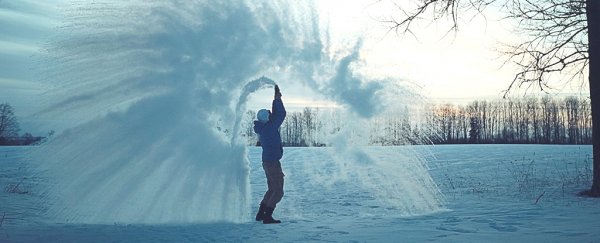It's one of the weirdest, most magical-seeming tricks there is: the ability to instantly transform hot, boiling water into an icy mist in the blink of an eye.
This bizarre demonstration of what's called the Mpemba effect might seem like sorcery, but just because you can impressively fling hot, scalding water into the sky above your head doesn't mean you should. In fact, you absolutely, positively shouldn't.
Unfortunately, in the midst of abnormally freezing temperatures in the US resulting from a certain polar vortex anomaly, lots of people are making use of the stunning, cold conditions to take part in a viral 'Boiling Water Challenge': hurling dangerously hot water into the wintry air around them to see what happens.
What happens, lots of the time, is these people get seriously burned when that scalding water lands on their skin – with one hospital outside Chicago announcing it had to treat numerous patients who ill-advisedly attempted the stunt last week.
"We've seen eight patients, and we're really surprised at how many people were trying the challenge and unfortunately failing," burns specialist Arthur Sanford from Loyola University Medical Centre told CBS.
According to Sanford, seven of these patients ended up being treated for blistered burns, with one female individual potentially requiring a follow-up operation due to the extent of the burns sustained.
But even more shocking is the age range of those coming in injured. The oldest patient seen by the Loyola burns unit so far was 53, but the youngest was just three years old – a sad casualty of being a bystander in close proximity to an older person who really should have known better.
"It's adults that are doing it… It's kids that are doing it. It's kids that are standing next to adults," Sanford told ABC 7 News.
"If you do make the decision to do this dangerous practice, [make sure] nobody is standing near you."
At its simplest, the Mpemba effect describes the process of hot water freezing faster than cold water, as unintuitive as that seems.
While scientists don't completely understand this strange phenomenon, there are at least five proposed mechanisms that could hypothetically explain it, centred around processes involving evaporation, convection, supercooling, how frost melts, and how gases dissolve.
#boilingwaterchallenge the other day in the #PolarVortex but I threw the water all over myself and everyone else. pic.twitter.com/js7B4uyf0Y
— Adam Bishop (@adammbishop) February 3, 2019
But even scientists who study the freaky transformation acknowledge there are weird variables and factors in the mix that we don't really or fully comprehend.
What precisely no-one is saying, however, is you should step outside your home with a pot of boiling water and conduct your own independent experiments on this – hurling a pail of scalding water wildly into the air, as your friends, family, and even children watch on at your side.
Affected by the polar vortex, MSU called off the classes for the seventh time in its history last week!!! Bored students attempted the #boilingwaterchallenge during the snow days. Check out this video to know how to make instant snow from boiling water: https://t.co/D8Cu7LDZy7 pic.twitter.com/ggSN8itH6W
— Jiaqi (Agnes) Bao (@Agnesbbao) February 6, 2019
"We strongly warn people to not perform the boiling water challenge," Sanford told the Chicago Sun Times.
"There is no safe way to do it."
That shouldn't need to be said, but it's worth repeating.
I mean, come on, it was National Burn Awareness Week last week. Many might not have heeded it, but they're definitely more aware of burns now.
